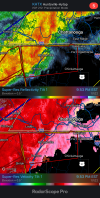.NEAR TERM /UNTIL 6 AM MONDAY MORNING/...
Forecast is on track in the immediate term, with isentropic ascent
beginning to force widespread
rainfall across the area. There is
concern, especially with 12z HREF suite, that 1-3" (with locally
higher amounts) of rain could fall over saturated grounds this
afternoon and tonight. As a result, we have issued a
Flash Flood
Watch along I-20 and east, and the Pee Dee Region. This runs from 4p
to 4a, and should cover the majority of the event. Be wary of
flood
prone roadway and locations as the rain falls this evening, as
flash
flooding is a possibility. Temperatures through the evening hours
will generally stay in the low and mid 60s as the system to our west
begins to materialize.
...Potential for Noctural Severe Thunderstorms, Including
Tornadoes...
SYNOPTIC SET UP
===============
Impressive and synoptically evident cold season severe weather event
looks like it could be on tap for the Carolinas. Positively tilted
and deep
shortwave trough currently over Oklahoma and TX will begin
to shift phases as an additional subtropical
jet streak pushes into
the base of the
trough and phase into the phased
jet structure
across the eastern US. This will quickly sharpen this
shortwave, and
force a close, negatively tilted
trough across the TN Valley by 1a
Monday. Ahead of this, a duel
jet streak structure will set up
across the Carolinas ahead of this, with the region placed in the
entrance region of a 185kt+ 250
hPa jet streak across the northeast
and the
exit region 120kt+ 250
hPa jet streak. It is quite
impressive, and will lead to a rapid response in the low-levels of
the
atmosphere. The
wind field is expected to strengthen very
quickly as we get into the overnight hours tonight, with an 80kt 500
hPa jet streak overspreading a 50kt 850
hPa low-level
jet.
Additionally, a strong surface low is expected to rapidly develop
and strengthen from central GA through central
NC tonight.
Guidance varies on strength, but its expected to strengthen from
nothing this morning to a deep, closed surface
cyclone between
998mb and 1000mb in strength.
MESOSCALE DETAILS
=================
This is quite the complicated set up for severe weather, and is
conditional (largely on realization of
instability). The
aforementioned surface low is expected to develop across
southwestern GA and move into northern SC. This will lift a warm
front north of the area, placing us in a narrow
warm sector over
much of our area as we get into the overnight hours. Surface
pressure falls will be on the order of 7-10mb/6hr, and this is
expected to result in backed and strengthening surface
flow through
the night. This will combine with the aforementioned strong low and
mid level
wind field to yield long and curved hodographs across the
region, with 0-1km
SRH on the order of 400+
m2/s2 across the region.
The primary question mark is that of
instability. There is a wide
range of thought on this, with some guidance pointing to 250-500
j/kg MLCAPE developing ahead of the
front, and others suggesting 0
j/kg MLCAPE will develop. The event hinges on whether or not we get
any appreciable
CAPE from this. And while synoptic forcing will be
very impressive, and
likely will augment any
MLCAPE we can get, if
we don`t actually get
CAPE then storms will have a hard time
surviving in that kind of
shear environment.
CONFIDENCE AND EXPECTATIONS
===========================
This is quite the challenging forecast, and forecaster confidence is
medium at best. The
SPC has placed the region in a
Slight Risk for
severe storms, owing to the high end
shear environment in place
across the region. However, the higher end
instability outcomes in
this set up would yield a high end severe weather threat. This
system is beginning to take shape currently with a surface low noted
across southern Alabama and southwestern Georgia. Within a
moisture
rich environment and increasingly strong
large scale ascent,
widespread showers and thunderstorms are expected to develop and
overspread the region over the next several hours.
The severe weather threat is not expected to begin materializing
until 10p or 11p this evening to our southwest. The surface low is
expected to be centered across northern Georgia by this point, and
widespread
convection will be developing ahead of the
front.
Hi-res
guidance is consistently indicating a narrow band of 61-64F
dewpoints ahead of the
front, which should be enough to yield 250-
500
j/kg of
MLCAPE. Given
synoptic scale forcing, this would be
enough to yield severe storms. I want to note - this is a thin
margin between
instability and no
instability. If the
instability
materializes, this could be a high end severe weather event, with
tornadoes (some strong) and damaging winds possible across the
forecast area. The entire area is under the gun, with areas along
and east of I-20 most
likely to see severe weather.
Something for the Carolinas to watch tonight. This looks like an all or nothing deal though depending on instability. This discussion is from CAE, but much of both states have this threat.


